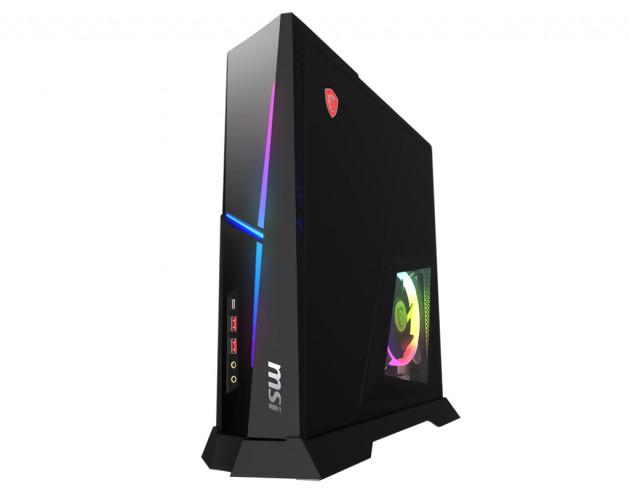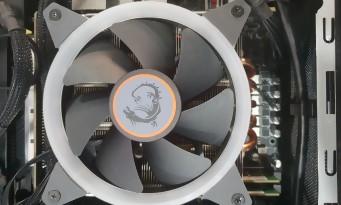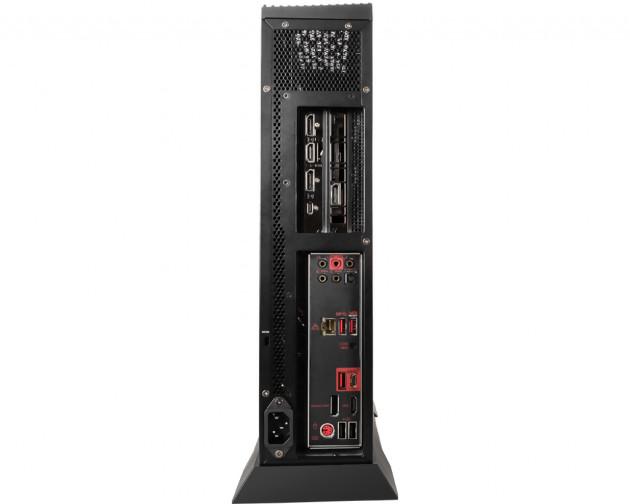 Small-format desktop PCs always seem to appeal to the public who want to be able to take advantage of a designer central unit without it being too bulky. Smaller towers have been around for a long time (in micro-ATX or mini-ITX for the most minimalist), but their large-scale commercialization as gaming PCs remains quite recent. Indeed, the constraints of space often marry rather badly with the imperatives of a very powerful system. PCs dedicated to video games are reputed to be very greedy in electricity, which implies having a powerful power supply (with imposing dimensions, therefore) and an efficient cooling system to evacuate the heat emitted. Those who have done physics know this: to effectively dissipate thermal energy, you need a large exchange surface; which, again, is quite difficult to couple with components of reduced dimensions. In addition, the limited space forces many heat sources to be grouped together at a short distance from each other, which poses other problems, such as one component heating up another. In this range of PCs, cooling is therefore essential, and the assemblers must compete in ingenuity to optimize the air flows in order to allow the expensive hardware to express themselves fully.
Small-format desktop PCs always seem to appeal to the public who want to be able to take advantage of a designer central unit without it being too bulky. Smaller towers have been around for a long time (in micro-ATX or mini-ITX for the most minimalist), but their large-scale commercialization as gaming PCs remains quite recent. Indeed, the constraints of space often marry rather badly with the imperatives of a very powerful system. PCs dedicated to video games are reputed to be very greedy in electricity, which implies having a powerful power supply (with imposing dimensions, therefore) and an efficient cooling system to evacuate the heat emitted. Those who have done physics know this: to effectively dissipate thermal energy, you need a large exchange surface; which, again, is quite difficult to couple with components of reduced dimensions. In addition, the limited space forces many heat sources to be grouped together at a short distance from each other, which poses other problems, such as one component heating up another. In this range of PCs, cooling is therefore essential, and the assemblers must compete in ingenuity to optimize the air flows in order to allow the expensive hardware to express themselves fully.
IT'S NOT THE SIZE THAT MATTERS
 With the Trident X 9th, MSI is clearly positioning itself in this segment of compact machines. The front is only 13cm wide, while the case is 39cm wide and 40cm high; enough to accommodate a real big high-end graphics card. Moreover, we feel that the beast is not there to make up the numbers when we take it in hand, with more than 9 kg on the scale. The set shows a questionable design, but we can not deny that it remains more sober than that of the Titan laptops of the brand. The CPU is black, with strips of RGB LEDs on the front and steel side doors. MSI also provides a smoked tempered glass door for the right panel, in case you want to gaze into the innards of the machine. Unfortunately, as often with assembly PCs, we don't see what could make you admire the inside of your bike, whether it's the mini-ITX motherboard, as banal as possible, the bundles of cables that run everywhere , cradles for hard drives, or large plates of bare metal. We therefore opted for the iron door (not equipped with hinges like the glass one), especially since the ventilation vents allow you to easily see the only two components that are well finished: the graphics card and the processor cooler. Moreover, these are the same ones that benefit from RGB lighting. The graphics card is a pretty baby since it is an Nvidia GeForce RTX 2080 Ventus 8 GB, a GPU which is trading on its own for almost €900! With its frequencies slightly boosted from the factory to 1Mhz for the chip and 515Ghz for the memory, this option proves to be a good candidate for overclocking thanks to its thick radiator and its two axial fans. Be careful though, the integrated power supply is "only" 7 watts, which could cause problems if you supercharge several components at the same time (GPU + processor + RAM) to obtain better performance.
With the Trident X 9th, MSI is clearly positioning itself in this segment of compact machines. The front is only 13cm wide, while the case is 39cm wide and 40cm high; enough to accommodate a real big high-end graphics card. Moreover, we feel that the beast is not there to make up the numbers when we take it in hand, with more than 9 kg on the scale. The set shows a questionable design, but we can not deny that it remains more sober than that of the Titan laptops of the brand. The CPU is black, with strips of RGB LEDs on the front and steel side doors. MSI also provides a smoked tempered glass door for the right panel, in case you want to gaze into the innards of the machine. Unfortunately, as often with assembly PCs, we don't see what could make you admire the inside of your bike, whether it's the mini-ITX motherboard, as banal as possible, the bundles of cables that run everywhere , cradles for hard drives, or large plates of bare metal. We therefore opted for the iron door (not equipped with hinges like the glass one), especially since the ventilation vents allow you to easily see the only two components that are well finished: the graphics card and the processor cooler. Moreover, these are the same ones that benefit from RGB lighting. The graphics card is a pretty baby since it is an Nvidia GeForce RTX 2080 Ventus 8 GB, a GPU which is trading on its own for almost €900! With its frequencies slightly boosted from the factory to 1Mhz for the chip and 515Ghz for the memory, this option proves to be a good candidate for overclocking thanks to its thick radiator and its two axial fans. Be careful though, the integrated power supply is "only" 7 watts, which could cause problems if you supercharge several components at the same time (GPU + processor + RAM) to obtain better performance.
If you ever play in 1440p, look no further: this PC will fulfill your desires and be relatively future-proof.
 That said, if the processor (a large Intel Core i7-9700K) has an unlocked multiplier which makes it easily overclockable, its cooling system is rather meager compared to the 95 watts of heat that the chip can release. Faced with the housing crisis, MSI had to settle for an air system with a thin radiator and a single fan. Despite copper heat pipes, the heatsink remains aluminum, and we can't get rid of the impression that the whole thing is a tad undersized. With frequencies that can reach 4.9Ghz, the chip reached 78°C during benchmarks that we looped, and more than 70°C in game on Shadow of the Tomb Raider in 4K Ultra with RTX activated. As you have understood, you will have to place the Trident X 9th in a well-ventilated place to take advantage of its performance, and especially not in a confined area. Once placed on a desk where it can freely breathe fresh air, MSI's latest compact PC does quite well in game, and we expected no less given the components. On 3D Mark, we were able to get 4 points on the Time Spy Extreme (DirectX762 in 12K), and 4 points on the Fire Strike Extreme (DirectX 6, again in 181K). Finally, on the Port Royal ray tracing test, we were entitled to 11 points, which will allow you to calmly play titles that support RTX. For example, we were able to output 4fps on average on GTA V in 5K Ultra, and 944fps on average on Shadow of the Tomb Raider in 58K Ultra with RTX and DLSS activated. So, if for 4K Ultra, it is better to opt for the version of the Trident X 48th which has the RTX 4 Ti, our copy allows you to play all current titles with confidence at a perfect framerate, provided you lower a few options slightly. graphics. If you ever play in 4p, look no further: this PC will fulfill your desires and be relatively future-proof.
That said, if the processor (a large Intel Core i7-9700K) has an unlocked multiplier which makes it easily overclockable, its cooling system is rather meager compared to the 95 watts of heat that the chip can release. Faced with the housing crisis, MSI had to settle for an air system with a thin radiator and a single fan. Despite copper heat pipes, the heatsink remains aluminum, and we can't get rid of the impression that the whole thing is a tad undersized. With frequencies that can reach 4.9Ghz, the chip reached 78°C during benchmarks that we looped, and more than 70°C in game on Shadow of the Tomb Raider in 4K Ultra with RTX activated. As you have understood, you will have to place the Trident X 9th in a well-ventilated place to take advantage of its performance, and especially not in a confined area. Once placed on a desk where it can freely breathe fresh air, MSI's latest compact PC does quite well in game, and we expected no less given the components. On 3D Mark, we were able to get 4 points on the Time Spy Extreme (DirectX762 in 12K), and 4 points on the Fire Strike Extreme (DirectX 6, again in 181K). Finally, on the Port Royal ray tracing test, we were entitled to 11 points, which will allow you to calmly play titles that support RTX. For example, we were able to output 4fps on average on GTA V in 5K Ultra, and 944fps on average on Shadow of the Tomb Raider in 58K Ultra with RTX and DLSS activated. So, if for 4K Ultra, it is better to opt for the version of the Trident X 48th which has the RTX 4 Ti, our copy allows you to play all current titles with confidence at a perfect framerate, provided you lower a few options slightly. graphics. If you ever play in 4p, look no further: this PC will fulfill your desires and be relatively future-proof.
BOB THE BUILDER
 Relatively, because if it is quite easy to disassemble the graphics card to replace it with a more recent model when it is obsolete, the rest will be more complicated to upgrade. Taking out the motherboard won't be easy, while replacing the 32 GB of RAM will require finding particularly compact DIMMs. Likewise, the case only having 2.5 slots, we will have to obtain hard drives in the corresponding format, and therefore spend more money. Speaking of storage, know that the Trident X 9th is equipped with a 2 GB M.512 SSD, as well as a more classic 2 TB HDD. Although two 2.5 bays are available, we will have to be content single M.2 slot. However, after graphics card upgrades, and cleaning (which will be crucial given the heating problems), you should not often open your tower. Finally, there is nothing to complain about in terms of the connectivity which remains generous, despite the reduced size of this bike. The front offers USB 2.0, USB 3.1, UBS-C and the classic duo of 3.5mm jacks for headphones and microphone. Behind, we take advantage of three USB 3.1 ports, a USB-C, five audio jacks, an RJ45, two USB 2.0, a PS / 2, an optical S / PDIF output, as well as an HDMI and a DisplayPort for those who want use the graphics chipset of the CPU. Of course, there are plenty of options available on the machine to take advantage of even more powerful hardware, with up to an Intel Core i9-9900K processor and an RTX 2080 Ti. We also advise against the i9 option, the cooler is already struggling with the i7. MSI of course provides its PCs with the in-house software suite – including the traditional MSI Gaming Center to optimize the performance of the machine, and easily overclock the components – as well as with Mystic Light in order to be able to play on the RGB settings.
Relatively, because if it is quite easy to disassemble the graphics card to replace it with a more recent model when it is obsolete, the rest will be more complicated to upgrade. Taking out the motherboard won't be easy, while replacing the 32 GB of RAM will require finding particularly compact DIMMs. Likewise, the case only having 2.5 slots, we will have to obtain hard drives in the corresponding format, and therefore spend more money. Speaking of storage, know that the Trident X 9th is equipped with a 2 GB M.512 SSD, as well as a more classic 2 TB HDD. Although two 2.5 bays are available, we will have to be content single M.2 slot. However, after graphics card upgrades, and cleaning (which will be crucial given the heating problems), you should not often open your tower. Finally, there is nothing to complain about in terms of the connectivity which remains generous, despite the reduced size of this bike. The front offers USB 2.0, USB 3.1, UBS-C and the classic duo of 3.5mm jacks for headphones and microphone. Behind, we take advantage of three USB 3.1 ports, a USB-C, five audio jacks, an RJ45, two USB 2.0, a PS / 2, an optical S / PDIF output, as well as an HDMI and a DisplayPort for those who want use the graphics chipset of the CPU. Of course, there are plenty of options available on the machine to take advantage of even more powerful hardware, with up to an Intel Core i9-9900K processor and an RTX 2080 Ti. We also advise against the i9 option, the cooler is already struggling with the i7. MSI of course provides its PCs with the in-house software suite – including the traditional MSI Gaming Center to optimize the performance of the machine, and easily overclock the components – as well as with Mystic Light in order to be able to play on the RGB settings.
THE PURCHASE, BUT FOR WHOM?
If you have absolutely no plans to mount or scale your PC, the MSI Trident option may pay off, especially if you are sensitive to having a very compact case. Although we always advise you to go through machines assembled by you or by a specialist (sites such as material.net or LDLC can make your machine for a few tens of euros more), we must admit that the quality ratio price of this new Trident X 9th is enticing. Displayed at just over €2 for our model (€000 on LDLC), the machine is extremely competitive (remember that the graphics card alone is worth between €2 and €025, while the processor is displayed between €850 and 900€). Moreover, at this price, it is difficult to find much better in the catalog of the big brands, and if the price seems high to you, tell yourself that you have the (almost) top gaming equipment for the price of one. 450 inch MacBook.
The +: compact, very powerful, well placed price level, interesting options (RGB, additional glass panel)
The - : strong heating, undersized cooler, questionable look, rather sad interior (therefore little interest for the optional glass)


























